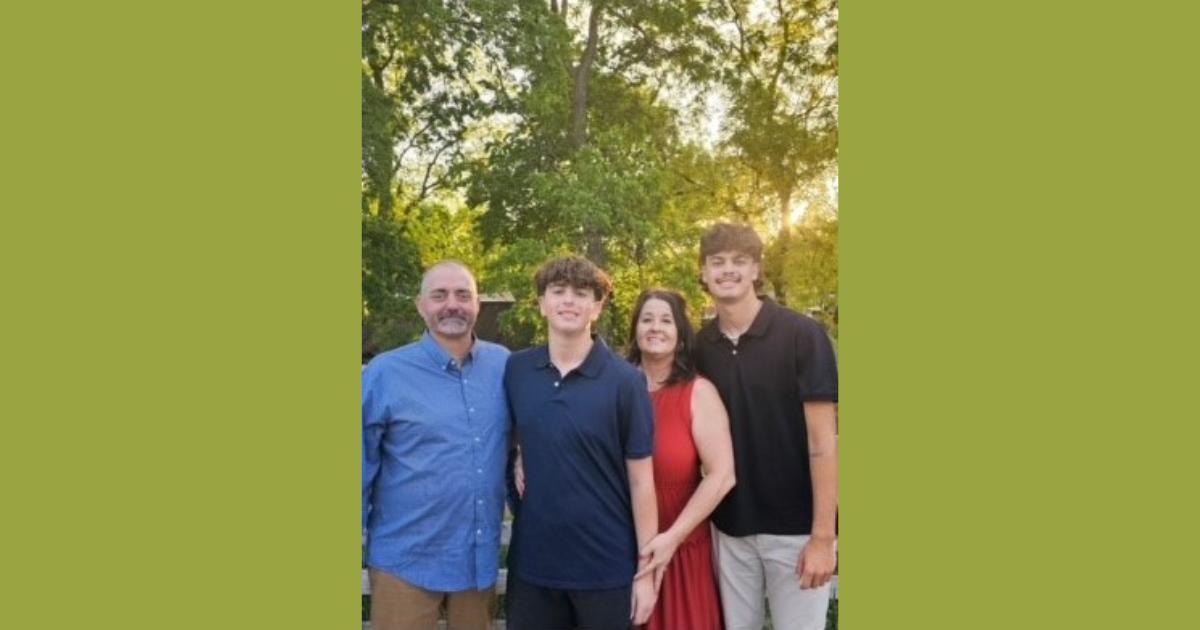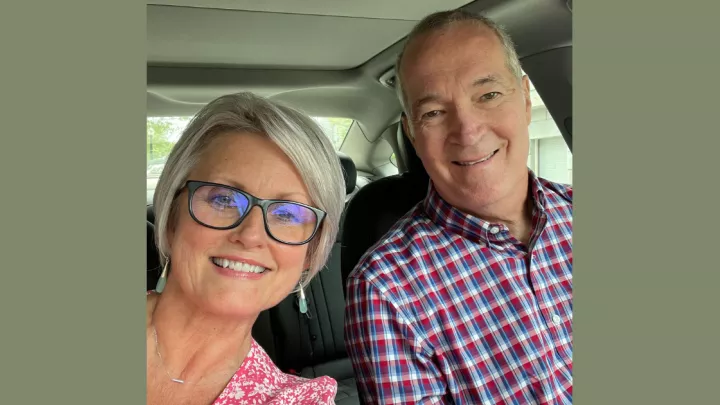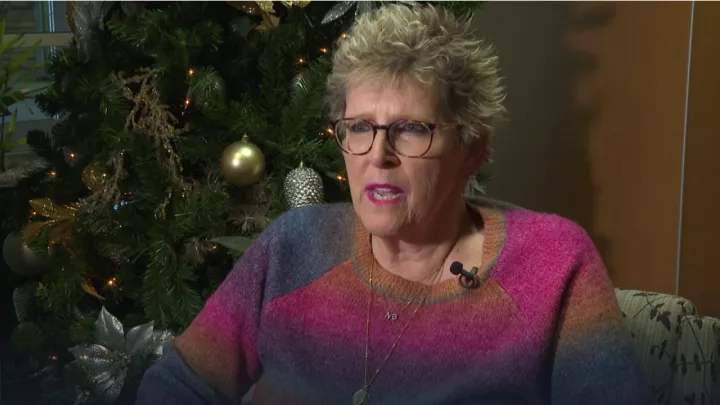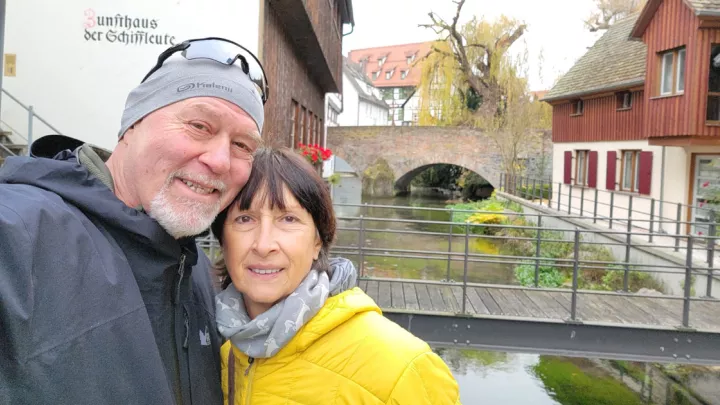Surviving aggressive blood cancer, twice

Pictured above: Patient Mark White, son Colin, wife Alicia Colanino-White and son Garrett
Mark White never expected a tonsillectomy would lead to a years-long battle with cancer. But in January 2017, at age 45, he received shocking news: Doctors had found mantle cell lymphoma in his removed tonsil.
"It was such a shock," White recalls. "I’d brought my 6-year-old son to my appointment, thinking it was just a routine follow-up. When they said, ‘We found cancer in your tonsil,’ I’m looking at my son, thinking, 'Am I going to see him grow up?'"
That diagnosis began a challenging journey for White, his wife, Alicia Colanino-White and their two sons. Now 52, White has survived two stem cell transplants in his fight against two different blood cancers.
After his initial diagnosis, White underwent chemotherapy and received a stem cell transplant using his own cells at Fred & Pamela Buffett Cancer Center - Nebraska Medical Center in June 2017. The treatment appeared successful, with no signs of cancer for years afterward.
But in the fall of 2023, everything changed again. Following a trip to Mexico, where he contracted the Zika virus, White developed heart inflammation that sent him to the emergency room. During his hospital stay, doctors discovered his blood counts were abnormal.
Additional examinations uncovered treatment-induced myelodysplastic syndrome (MDS), a form of blood cancer that sometimes develops following certain cancer therapies. Even worse, White's MDS was an aggressive subtype with mutations that made it difficult to treat.
"It happened so fast," White says. Just months earlier, he'd been cleared at a routine cancer checkup.
Michael Haddadin, MBBS, a hematologist-oncologist who began treating White in 2023, knew they faced a formidable opponent.
"Unfortunately, it was the most aggressive type of MDS that anyone can have," Dr. Haddadin says. He recommended an innovative chemotherapy approach, doubling the typical treatment duration from five to 10 days.
"There's good data that this chemotherapy should be given for 10 days in this subtype of MDS," Dr. Haddadin says. "This is not a widely adopted approach, except in large cancer centers such as ours."
The intensive treatment took a toll. White developed severe swelling in his tongue and throat that required intubation and a month-long hospital stay. But ultimately, it produced dramatic results.
"He's one of my patients that has had the cleanest possible bone marrow biopsy after this regimen," Dr. Haddadin says. "I'm really happy for him."
With the cancer in check, White and his medical team faced another weighty decision: whether to pursue a second stem cell transplant, this time using donor cells. According to Dr. Haddadin, this type of transplant is more intensive but offers the best chance of cure for different types of MDS.
"Mark was saying, 'Let's do it. I know the risk, let's do it,'" Dr. Haddadin recalls. "Alicia tried to dig deep, asking lots of reasonable questions, understandably."
Because White was responding well to treatment, he could have opted to continue maintenance chemotherapy for the foreseeable future. However, the odds of his cancer returning were significant, and if he waited, he may not be a candidate for a second stem cell transplant.
Colanino-White says she remembers asking herself, "Does it need to be done? Do we need to go this extreme?" However, after careful consideration and many conversations with Dr. Haddadin, the couple decided to move forward. They knew it offered the best chance for long-term survival.
"In the back of my mind, I always knew I was going to do it," White says. "I look at my kids, and I'm like, I've got to do it for them."
In March 2024, White received his second stem cell transplant using cells from an anonymous young adult donor. While the procedure and recovery proved challenging, White has shown remarkable resilience.
Just a few months after his transplant, he returned to his physically demanding job at UPS. He was able to coach his younger son, now 13, in baseball over the summer. While he’s not back to full strength, he's steadily improving.
"There was a point I had to crawl up the stairs at home," White says. "Last fall, I had a walker. I had a cane. So, to be here now and say, I'm strong, and each day I get stronger – it's just amazing how your body can recover."
Dr. Haddadin credits several factors for White's successful outcome: An innovative treatment approach, the Nebraska Medicine comprehensive care model, White’s overall health and positive attitude and the unwavering support of his family.
Colanino-White, in particular, played a crucial role as Mark's advocate. "She was pretty meticulous with following everything," Dr. Haddadin says. "She would call and say, 'This mutation came back. What do you think?'"
The couple emphasizes the importance of a strong support system for other families facing similar battles. "If someone wants to help, please lean on them," Colanino-White advises. "You can't take it all in yourself."
Along with his family and friends, White found comfort in his faith and his supportive medical team. "Dr. Haddadin was great," he says. "Our questions were always answered, and he made us feel comfortable."
While White continues maintenance chemotherapy, he's cautiously optimistic about the future. Dr. Haddadin's goal is for White to reach the two-year post-transplant mark. After that, the likelihood of the disease returning is rare.
For now, White is focused on regaining strength and enjoying time with family. This year, he hopes to celebrate his November birthday at home – a stark contrast to last year's hospital-bound celebration, when he looked out the window to see a large group of friends cheering him on from the parking lot.
"You look back, and it's like, 'That was rough. Those were hard days,'" he says. "I mean, it makes me emotional. Sometimes it's just tough, and then you say, thank God we got through it. We're stronger for it."







